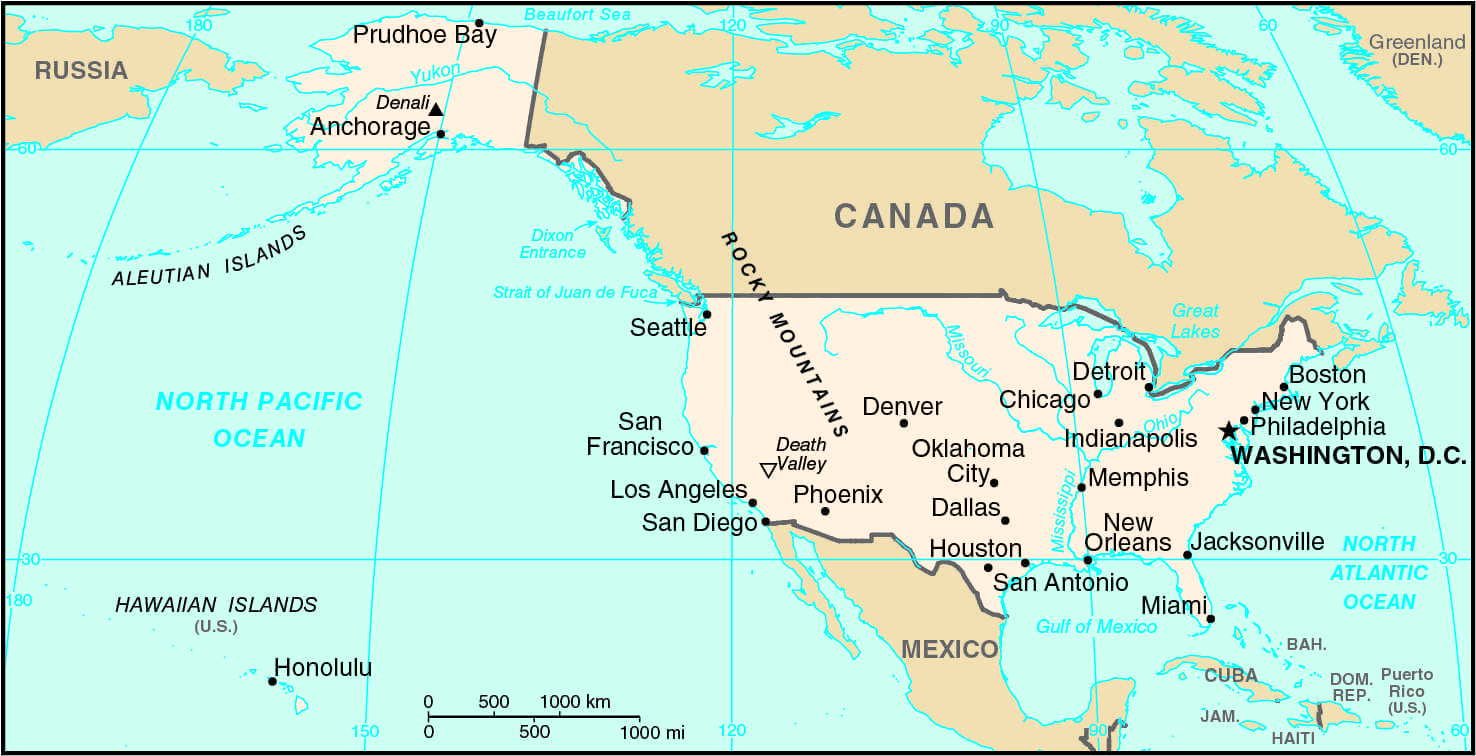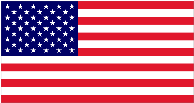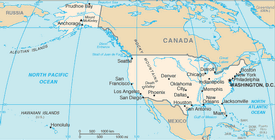Official Name: United States of America
National Symbol: Bald Eagle
Internet Domain: .us
International Dialing Code: +1
Location and Size
The United States is located on the North American continent between Canada and Mexico. It borders both the North Atlantic Ocean and the North Pacific Ocean. The country’s total area is 9,826,675 sq km, making it the 3rd largest country in the world, behind Russia and Canada..
Government
The US government is a constitution-based federal republic with strong democratic tradition. It’s made up of 50 states and 1 district (Washington, DC), along with 14 island dependent territories.
Branches:
- Executive: Chief of state and head of government President Donald TRUMP; Vice President Michael PENCE; cabinet appointed by the president with Senate approval
- Legislative: Bicameral Congress consisting of the Senate (100 seats, 2 members elected from each of the 50 states to serve 6 year terms); and, the House of Representatives (435 seats, members directly elected by popular vote to serve 2 year terms)
- Judicial: Supreme Court (9 justices nominated by the president and confirmed with the advice and consent of the Senate; appointed for life); US Courts of Appeal, District Courts, State and County Courts
Legal System
At the federal level, the U.S. has a common law system based on English common law. State legal systems are also based on common law except for Louisiana, which is based on the Napoleonic civil code.
The country withdrew its acceptance of compulsory International Court of Justice (ICJ) jurisdiction in 2005. (What does this mean?) It withdrew acceptance of the International Criminal Court ( ICCt) jurisdiction in 2002.
Ten Interesting Facts About the United States
- Atlanta (Georgia) International Airport is the world’s busiest airport.
- The Hollywood Bowl (Hollywood, California) is the world’s largest amphitheater.
- The first motion picture theater opened in Los Angeles (California) in 1902.
- Wabash, Indiana was the first electrically lighted city in the world.
- The State of Kentucky has the largest cave system in the world ” the Mammoth cave system has over 200 miles of caves.
- Although English is the most commonly spoken language used in the US and is the language used in government, the country has no official language.
- The United States Navy has the second largest air force in the world. The United States Air Force has the first.
- John Wilkes Booth shot Lincoln in a theater and was found in a warehouse. Lee Harvey Oswald shot Kennedy from a warehouse and was found in a theater.
- The Pentagon is the largest office building in the world by area.
- The largest city (by land area) in the United States is Juneau, Alaska. It covers about 3,000 square miles. Jacksonville, Florida is the largest in the lower 48 states at just over 800 square miles
Economy
The US has the largest and most technologically powerful economy in the world, with a per capita GDP of $59,800. In this market-oriented economy, private individuals and business firms make most of the decisions, and the federal and state governments buy needed goods and services predominantly in the private marketplace.
The global economic downturn, the sub-prime mortgage crisis, investment bank failures, falling home prices, and tight credit pushed the United States into a recession in mid-2008. GDP contracted until the third quarter of 2009, making that time the deepest and longest downturn since the Great Depression. Due to the government’s large-scale budget and monetary stimulus plan, which among others stimulated household consumption, the economy recovered in 2010, with a growth of 3%. In 2011, growth again slowed down as a result of the downturn in private investment, a drop in exports and the growth in public spending. Due to the risk posed by the eurozone crisis on the US economy, weak growth is expected for 2012.
Leading Markets (2017): Canada 18.3%, Mexico 15.7%, China 8.4%, Japan 4.4%
Leading Exports-commodities (2018): Machinery (including computers) 12.8%, Mineral Fuels (including oil) 11.4%, Electrical Machinery & Equipment 10.6%, Aircraft & Spacecraft 8.4%, Vehicles 7.8%, Optical, technical and medical apparatuses 5.4%, Plastics 4%, gems and precious metals 3.8%, Pharmaceuticals 2.9%, Organic chemicals 2.4%.
Leading Suppliers (2017): China 21.6%, Mexico 13.4%, Canada 12.8%, Japan 5.8%, Germany 5%
Leading Imports-commodities: Machinery (including computers) 14.8%, Electrical machinery & equipment 14%, Vehicles 11.7%, Mineral fuels (including oil) 9.2%, Pharmaceuticals 4.5%, Optical, technical and medical apparatus 3.6%, Furniture, bedding lighting, signs and prefab buildings 2.8%, Plastics 2.4%, gems and precious metals 2.3%, Organic chemicals 2.1%
Top Industries: Highly diversified, world leading, high-technology innovator, second largest industrial output in world; petroleum, steel, motor vehicles, aerospace, telecommunications, chemicals, electronics, food processing, consumer goods, lumber, mining
Top Agricultural Products: Wheat, corn, other grains, fruits, vegetables, cotton; beef, pork, poultry, dairy products; fish; forest products
Comparative Economic Indicators ” 2018
| USA | Canada | China | Germany | Japan | Mexico | |
| Population* (millions) | 329.25 | 35.88 | 1,284.0 | 80.46 | 126.10 | 125.96 |
| Population growth rate (%) | 0.8 | 0.72 | 0.37 | -0.17 | -0.24 | 1.09 |
|
Age Structure (%)
(15 to 64 years old)
|
65.35 | 65.48 | 72.01 | 64.81 | 58.92 | 66.13 |
|
Age Structure (%)
(65+ years old)
|
16.03 | 19.08 | 11.27 | 22.36 | 28.38 | 7.26 |
| Literacy (%) | 99.0 | 99.0 | 95.0 | 99.0 | 99.0 | 95.0 |
| Unemployment rate (%) | 4.4 | 6.3 | 3.9 | 3.8 | 2.9 | 3.4 |
| Inflation (%) | 2.2 | 3.0 | 6.9 | 2.5 | 1.7 | 2.0 |
| Population below poverty line (%) | 15.1 | 9.4 | 3.3 | 16.7 | 16.1 | 46.2 |
| GDP** (USD billions) | 14,490 | 1,774 | 23,210 | 4,199 | 5,443 | 2,463 |
| GDP real growth rate (%) | 1.5 | 2.2 | 9.2 | 2.7 | -0.5 | 3.8 |
| GDP per capita** (USD) | 59,800 | 48,400 | 16,700 | 50,800 | 42,900 | 19,900 |
| Public debt (% of GDP) | 78.8 | 89.7 | 47.0 | 63.9 | 237.6 | 54.3 |
| Industrial production growth rate (%) | 2.3 | 4.9 | 6.1 | 3.3 | 1.4 | -0.6 |
| Exports (USD billions) | 1,553.0 | 423.5 | 2,216.0 | 1,434.0 | 688.9 | 409.8 |
| Imports (USD billions) | 2,361.0 | 442.1 | 1,740.0 | 1,135.0 | 644.7 | 420.8 |
| Reserves of foreign exchange and gold (USD billions) | 123.3 | 86.68 | 3,236.0 | 200.1 | 1,264.0 | 175.3 |
| Currency | Dollar USD |
Dollar CAD |
Yuan Renminbi CNY |
Euro EUR |
Yen JPY |
Peso MXN |
| Exchange rates (per USD) 05/22/2012 | na | 1.31 | 6.88 | 0.88 | 107.68 | 19.14 |
| Exchange rates (per EUR) 5/22/2012 | 0.88 | 1.49 | 7.83 | n/a | 122.58 | 19.79 |
| Rating in 2011 Corruption Perceptions Index*** | 7.1 | 8.1 | 3.9 | 8.0 | 7.3 | 2.8 |
| Rating in 2012 Index of Economic Freedom*** | 76.8 | 77.7 | 58.4 | 73.5 | 72.1 | 64.7 |
* July, 2018 estimates
** PPP ” Purchasing Power Parity
*** 2018 Corruption Index: 10=Very Clean; 0=Highly Corrupt
****2018 Index of Economic Freedom: 100-80=Free; 49.9-0-Repressed
Economic Data from CIA World Factbook
2019 Corruption Perceptions Index, Transparency International
2018 Index of Economic Freedom, Heritage Foundation
Credit and Collections
ABC-Amega’s collection experience in the United States
A few important points to note about collections in the United States:
- Always get a credit application and a credit report on the US business you plan to sell to on credit. Make sure you have the company’s correct legal name so the credit reporting agency can provide you accurate information.
- In general, the probability of collecting on a past due account at 30 days past due is 93.1%; at 90 days past due the likelihood of collecting decreases to 73.1%; at 6 months it decreases to 50%; at 1 year to 25%; at 2 years just 10.5%. Do not hold onto your claims for more than a maximum of 90 days past the due date.
- There are strict Statutes of Limitations in each US state which determine how long you have to collect on your past due accounts. The statute of limitations on open account terms is just three years in many states. Where a contract has been negotiated, the statute of limitations is usually three to six years. Most purchasers in the US are very aware of these time limits. Those that don’t plan to pay count on the fact that foreign creditors are not aware of these statutes.
Dispute Resolution
It is a good idea to utilize Final and Binding Arbitration, where possible, to handle collection disputes. The United States is a signatory to the 1958 NY Convention on the Enforcement of Foreign Arbitration Awards. This link will provide information on Domesticating a Foreign Arbitration Award.
If you find yourself in the position of having to consider legal action, consider these 10 questions first. Should you have to file a lawsuit in the United States, you should be aware of the collection suit process and what will be required of you.
Risk Assessment
According to Coface:
“There were slender, but positive, signs that gave grounds for hope at the end of 2011 that the [US] economy was at last set to improve. The trend at the beginning of 2012 however remained negative but the good news has been confirmed and boosted the level of household consumption, the main driving force in the economy (71% of GDP). – The banking sector is on the whole stronger than in 2008: better capitalization, improvement in the quality of loans thanks to the decline in defaults by households and businesses, which have returned to pre-crisis levels. But there are still weaknesses in particular because of the sector’s exposure to private and public counterparties in the Eurozone. – But, as whole, businesses are not highly indebted, which is an advantage in an uncertain macroeconomic context.”
Coface Country Rating: A2 — The political and economic situation is good. A basically stable and efficient business environment nonetheless leaves room for improvement. Corporate default probability is low on average.
Coface Business Climate Rating: A1 — The political and economic situation is very good. A quality business environment has a positive influence on corporate payment behavior. Corporate default probability is very low on average.
Credendo Political Risk Rating: 1 — Lowest risk
Credendo Commercial Risk Rating: A — Lowest risk
Business Climate
Economic Freedom: The United States’ economic freedom score of 76.8 drops it to 12th place in the 2019 Index of Economic Freedom . Its score increased 1.1 points since the year before, reflecting rising scores for government spending, freedom from corruption, and investment freedom. The US is ranked 2nd out of three countries in the North America region, and its overall score remains well above the world and regional averages.
Market Access: Foreign corporations have the opportunity to do business throughout the United States. The federal government provides equal treatment to domestic and foreign investors. While not granting special tax packages or concessions to foreign investors, the government does refrain from imposing discriminatory tax burdens on them.
US business firms face higher barriers to enter their US rivals’ home markets than foreign firms face entering US markets.
Regulatory System: The US regulatory environment is a combination of open competition and consumer protection. There is much bureaucracy as the laws that govern the US are legislated and enforced by the central (Federal) government, state governments, county governments, city, town and village governments and other municipal entities.
Intellectual Property Rights: The US has a well-developed system of licensing that protects patents, trademarks and copyrights. Each has its own set of rules and procedures. The holder of a US patent, trademark or copyright may sue the infringer through the US federal court system. The holder may also obtain an injunction and sue for damages.
Exchange Control: The Treasury Department regulates capital and exchange controls in the US. It imposes no general restrictions on remittances of profits, dividends, interest, royalties or fees to non-residents.
Corruption: The United States’ overall score was 7.1 (ranking 22nd out of 180) in Transparency International’s 2018 Corruption Perceptions Index.
Business Protocol in the United States
- What is considered appropriate business attire varies by geographic region, day of the week and industry. “Casual Friday” is common in many companies. High technology companies often wear casual clothes every day. For an initial meeting, dressing conservatively is always in good taste.
- In most situations, you can begin calling people by their first names; most will insist that you call them by their nickname, if they have one. In formal circumstances, you may want to use titles and surnames as a courtesy until you are invited to move to a first name basis, which will happen quickly.
- Business cards are exchanged without formal ritual. It is quite common for the recipient to put your card in their wallet, which may then go in the back pocket of their trousers. This is not an insult.
- Americans are direct. They value logic and linear thinking and expect people to speak clearly and in a straightforward manner.
- Americans will use the telephone to conduct business that would require a face-to-face meeting in most other countries. They do not insist upon seeing or getting to know the people with whom they do business.
- Arrive on time for meetings since time and punctuality are important to Americans. The concept “time is money” is taken seriously in US business culture. Meetings may appear relaxed, but they are taken quite seriously. If there is an agenda, it will be followed. If you make a presentation, it should be direct and to the point. Use statistics to back up your claims, since Americans are impressed by hard data and evidence.
- Be aware that the United States is the most litigious society in the world. There are lawyers who specialize in practically every industry and segment of society.
More information on Business Protocol:
Sources for further information on doing business in Country
American Chamber of Commerce in France
Doing Business, USA – World Bank Group
*****
Subscribe to the Credit-to-Cash Advisor
Monthly e-Newsletter — It’s Free
This information is provided by ABC-Amega Inc. Providing international receivable management and debt collection services for exporters to more than 200 countries including the United States. For further information, contact [email protected].
This report represents a compilation of information from a wide variety of reputable sources.
Comparative Economic Indicators: CIA World Factbook
Risk Assessment information: Coface Country Rating, Ducroire/Delcredere and Political Risk Insurance Center.
Exchange Rates: OANDA.com The Currency Site.


